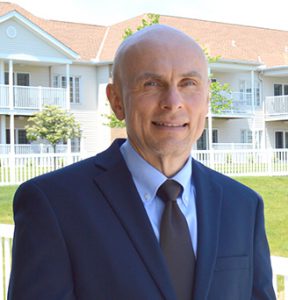Five things
Hobbies: Exercising, spending time with his wife and drinking wine
Favorite place in Northeast Ohio: Hinckley Lake
Top of the travel bucket list: The outdoor Christmas markets in Austria and southern Germany
Favorite book: The Bible
Guilty pleasure: Using the biggest wine glass he can find and filling it to the top
Lunch spot
Square 22 Restaurant and Bar
13485 Pearl Road, Strongsville
The meal
Avocado Caesar Wrap with kettle chips and an iced tea; Faroe Island Salmon
The vibe
Square 22 serves up new American food in an edgy setting. The restaurant and bar balances a casual and chic feel with its cozy fireplace, red-lit bar, dark wood and large windows.
The bill
$35.59, plus tip
With 125 years now under its belt, Altenheim Senior Living is prepared for the future, said Paul Psota, CEO of the nonprofit life plan community. Altenheim is celebrating its 125th anniversary this year — and still growing, with projects totaling about $21 million in capital investments.
Shurmer Place Memory Assisted Living, slated to open in October, is dedicated to seniors dealing with Alzheimer’s and dementia issues and will be staffed with certified dementia practitioners. Altenheim’s Therapy Rehab Center, scheduled to open next January, will be dedicated to individuals who require post-hospital inpatient and/or outpatient therapies or rehabilitative services.
How do the past 125 years affect the work of Altenheim today?
Altenheim was founded as a not-for-profit organization having the purpose of serving Greater Cleveland’s seniors. It was founded by 60 (or so) German-American women of the West Side German Women’s Club. With about $260, and a lot of faith, they began construction of a home for the aged (in German, an “Altenheim”) on Detroit Road in or about 1887. It opened in 1892. The Women’s Club continues to be active in carrying out the organization’s mission, strictly as volunteers, to this day. Their passion and altruistic motives permeate Altenheim’s culture today.
How has Altenheim grown in that time, especially in the last decade?
Altenheim operated in its initial facility in Cleveland until 1980, when it moved to Strongsville. At that time, it expanded by purchasing an existing 100-bed nursing facility. Since then, the number of skilled nursing beds gradually expanded to 160. Beds will increase again, to 170, next January with the addition of Altenheim’s new Therapy Rehab Center. In 2001, Altenheim expanded its services to residential care by opening Shurmer Place at Altenheim (at that time offering 60 independent and assisted living apartments). In fall 2014, Shurmer Place expanded by adding 25 more independent and assisted living apartments. It has 85 in total now. Shurmer Place will add 38 more apartments this fall with the opening of Shurmer Place Memory Assisted Living. It will have 123 in total. In late 2014, Altenheim expanded its service offerings again by opening Altenheim Home Health Care. The agency offers skilled nursing and therapy services to homebound clients in their own homes. On Dec. 1, 2016, Altenheim purchased a well-established outpatient therapy clinic, Hands-On Physical Therapy Specialists. Hands-On provides outpatient physical and occupational therapies to the community, and has a certified hand therapy specialist. Also, just recently, Altenheim opened Altenheim at Home, offering private duty assistance services to clients in their homes. Altenheim has also been serving homebound Strongsville seniors with Meals on Wheels for the past three decades.
What are some of the biggest challenges in senior care today?
The number of seniors requiring various services over the next few decades will explode. That’s the good news for our industry. The bad news is, who’s going to pay for needed services? Federal and state governments and private insurance carriers are constantly striving to implement service models that provide less reimbursement to providers and, in some instances, do not serve the best interests of clients. Trends in the industry include tying reimbursement to measurable quality outcomes; penalizing providers for expending too much on care; shifting reimbursement from inpatient services to home and community based services; and, shifting insurance coverages from governmental Medicare and Medicaid programs to private carrier programs.
How will Altenheim address these going forward?
Altenheim’s ongoing priority is to maintain and improve quality outcomes for its clients, families and the community served. Acute care providers and other providers in the care continuum will strive to partner with organizations that can demonstrate quality outcomes over the long haul. Altenheim has also expanded its service offerings to align with changing reimbursement models and client demands, e.g., by providing skilled and private duty services in clients’ own homes; by specializing in its service offerings, e.g., memory care; and, by revamping its in-patient services to accommodate the hospitality environment that Baby Boomers demand.
How do you think the Northeast Ohio community needs to prepare for and respond to an aging population?
Health care providers, employers, insurance carriers and other community organizations should develop, implement and incentivize preventative practices in the way its clients, employees, enrollees and members live their lives. Nutrition, physical activities, positive emotional outlets, support groups and community information resources all have the potential to lessen the economic, physical, social and emotional burdens that will be associated with caring for an unprepared aging population.
The original article can be found here: http://www.crainscleveland.com/article/20170305/NEWS/170309912/source-lunch-with-paul-psota


